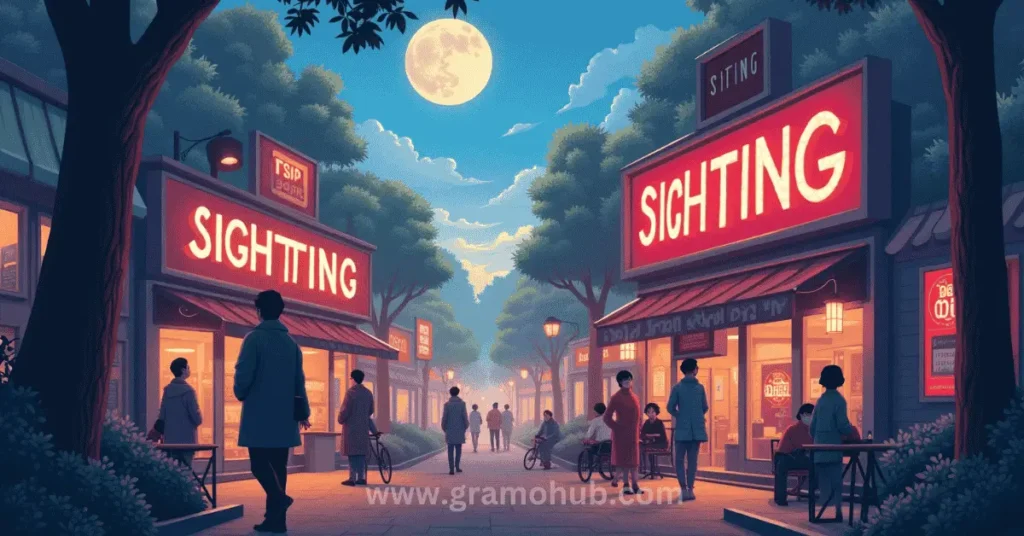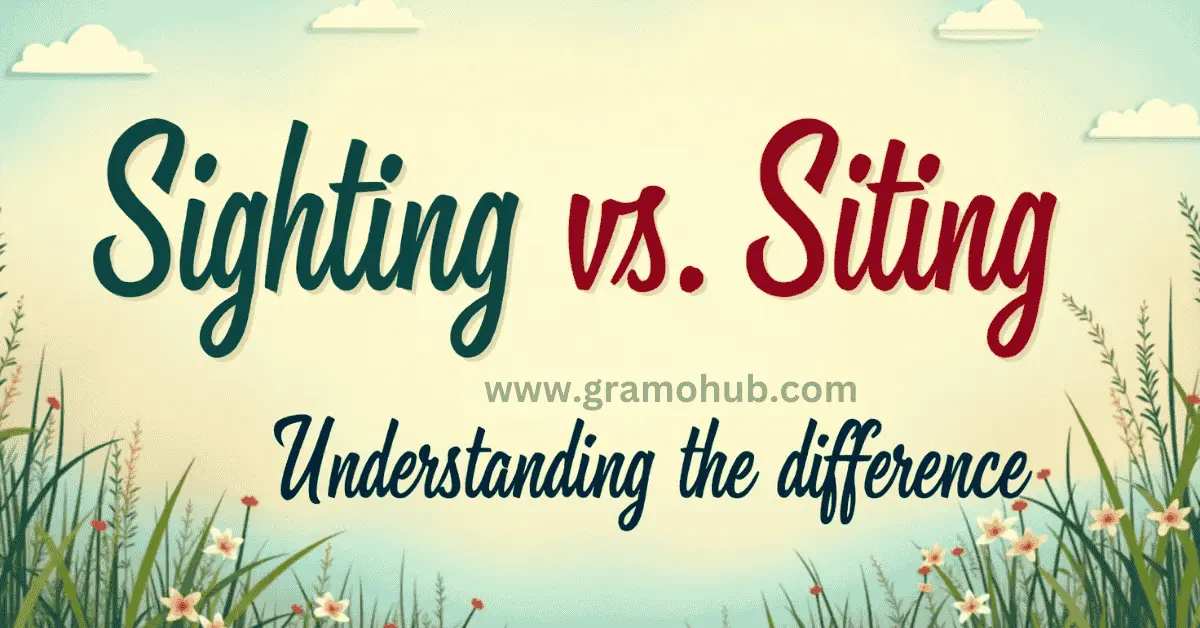When it comes to the English language, a single letter can sometimes change the meaning of a word completely. “Sighting” and “siting” are two such words that many people confuse. Though they sound similar, they have entirely different meanings and are used in distinct contexts.
In this blog post, we’ll dive into the difference between “sighting” and “siting,” explore when to use each term, and provide examples to help you master both.
What Does “Sighting” Mean?
“Sighting” refers to the act of observing or spotting something, especially something rare or unusual. The term is often used when you see something that is noteworthy or out of the ordinary. For example, spotting a rare animal or celestial object could be referred to as a “sighting.”
In many cases, “sighting” is used in the context of wildlife watching, astronomy, or when someone sees something unexpected or significant. Whether you’re out on a hike or stargazing, the word “sighting” fits perfectly for any observation of interest.
For example, when you go birdwatching, any unusual bird species you spot can be described as a “sighting.” In astronomy, observing a comet or meteor shower also qualifies as a “sighting.”
What Does “Siting” Mean?
“Siting,” on the other hand, refers to the act of selecting or determining the location for something, such as a building, project, or infrastructure. It’s a term often used in fields like urban planning, engineering, and architecture.
The process of siting involves choosing a spot for a specific purpose, considering factors like accessibility, environmental impact, and safety. It’s a strategic decision that requires expertise and careful planning.
For instance, engineers and planners might be tasked with siting a new hospital in an area that is easily accessible to the public while considering its environmental impact. This process is essential in ensuring the success and safety of the project.
How to Use “Sighting” and “Siting” Correctly
The key to using “sighting” and “siting” correctly lies in understanding their meanings and context. “Sighting” is about seeing or spotting something significant, while “siting” refers to selecting a location for a project or building.

To avoid confusion, remember that “sighting” has to do with observation, whereas “siting” is all about the selection of a place. If you’re describing something you saw or noticed, “sighting” is the correct choice.
On the other hand, when discussing the act of choosing a place for a project or structure, “siting” is your go-to term. This distinction will help you use both terms accurately and confidently in your writing and speech.
“Sighting” vs. “Siting”: Key Differences at a Glance
| Sighting | Siting |
| Refers to the act of seeing something. | Refers to the process of selecting a location. |
| Often used in wildlife, astronomy, and rare events. | Common in construction, planning, and engineering. |
| Involves spotting something unusual or significant. | Involves choosing the best place for a project or structure. |
Understanding the difference between “sighting” and “siting” becomes much easier when you look at their use cases. “Sighting” is used when talking about something you’ve seen, and “siting” is used when talking about where something is placed.
The context is essential. If you’re talking about wildlife, nature, or even a rare celestial event, “sighting” is the right term. If you’re talking about a location for construction or other projects, “siting” is the proper choice.
Common Mistakes with “Sighting” and “Siting”
One of the most common mistakes is mixing up “sighting” and “siting.” Many people mistakenly use “sighting” when they really mean “siting” and vice versa. For example, saying, “I’m siting a rare bird” is incorrect. The correct phrase would be “I’m sighting a rare bird.”
To avoid making this mistake, always remember that “siting” is about choosing locations, while “sighting” refers to observing or spotting something. If you’re unsure, think about whether the word is describing the act of seeing or the process of selection. This simple approach will help you avoid confusion.
Also, it’s important to note that “sighting” is more common in casual conversations, while “siting” is typically reserved for professional settings. The professional nature of “siting” makes it more relevant in technical discussions about urban planning or construction projects.
How to Remember the Difference
A simple way to remember the difference between “sighting” and “siting” is to associate each word with a specific concept. “Sighting” is related to seeing something, while “siting” is about choosing a location for something.

One helpful trick is to think of the “e” in “sighting” as representing “eyes.” After all, sighting involves your eyes and the act of observing something. In contrast, the “i” in “siting” can remind you of “installation” or “infrastructure,” which are related to location selection.
These associations will make it easier to choose the right word depending on the context. If you’re discussing observation, remember “sighting.” If you’re talking about selecting a place, use “siting.”
How to Apply “Sighting” and “Siting” in Different Contexts
Sighting in Everyday Life
“Sighting” often comes up in everyday life when people are discussing something rare or unique they’ve observed. For example, a friend might share that they had a rare bird sighting during their morning walk.
In these cases, “sighting” helps to describe the event of spotting something of interest. Whether it’s an animal, a person, or even a weather phenomenon like a rainbow, “sighting” is the perfect word to describe the experience of seeing something noteworthy.
It’s common to hear people talk about a “sighting” when referring to UFOs or other unusual occurrences, too. It’s the word used when something stands out visually and catches your attention.
Siting in Professional and Technical Fields
“Siting” plays an essential role in fields like urban planning, construction, and architecture. In these professional areas, siting is the process of selecting a specific location for a building or infrastructure project based on various factors, such as accessibility, environmental impact, and safety.
For example, when siting a new hospital, the location must be easily accessible to patients while also considering surrounding environmental conditions. The correct siting of a hospital ensures that it serves the community well and meets regulatory and safety standards.
In construction, siting is a vital process for ensuring that structures are built in the most suitable locations. This requires expertise in geography, environmental science, and planning to ensure that a project meets its intended purpose.
Why Getting “Sighting” and “Siting” Right Matters
Impact on Clarity and Communication
Using “sighting” and “siting” correctly is crucial for clarity. Confusing these terms can cause misunderstandings, especially when the context is critical. For instance, saying “We are siting a rare bird” would make no sense and confuse your audience.
Correct usage helps communicate your ideas more effectively, especially in writing. Whether you’re writing an academic paper, professional report, or casual blog post, using the right word ensures that your message is clear and accurate.
Professional and Academic Importance
In professional and academic writing, precision is key. Using “siting” and “sighting” incorrectly could affect the quality of your work. For example, in urban planning, incorrect usage might impact a project’s planning documents or communication with stakeholders.
When discussing rare events, wildlife sightings, or astronomical observations, using “sighting” accurately adds authority to your writing. It shows that you understand the difference and can communicate your ideas clearly and professionally.
Conclusion: Mastering “Sighting” vs. “Siting” for Clear Communication
In conclusion, understanding the difference between “sighting” and “siting” is essential for clear communication. These words may sound alike, but they have distinct meanings and are used in different contexts.
“Sighting” is related to observing or spotting something noteworthy, while “siting” is about selecting a location for something important. Whether you’re discussing a rare wildlife sighting or the siting of a new building, knowing the correct term ensures your writing remains clear and professional.
FAQs about “Sighting” vs. “Siting”
FAQ 1: Can I use “sighting” for selecting a location?
No, “sighting” refers to the act of seeing something, not choosing a location.
FAQ 2: Is “siting” only used for construction?
No, “siting” can be used in any context where a location is selected, such as urban planning or environmental studies.

